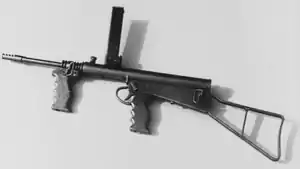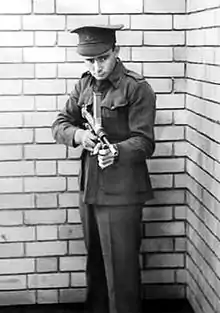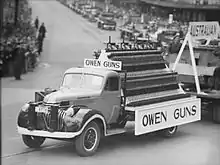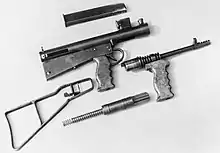Owen gun
The Owen gun, known officially as the Owen machine carbine, was an Australian submachine gun designed by Evelyn Owen in 1938. The Owen was the only entirely Australian-designed and constructed service submachine gun of World War II and was used by the Australian Army from 1942 until 1971.
| Owen gun | |
|---|---|
 The final design of the Owen machine carbine | |
| Type | Submachine gun |
| Place of origin | Australia |
| Service history | |
| In service | 1942–1971 |
| Used by | See Users |
| Wars | |
| Production history | |
| Designer | Lieutenant Evelyn Owen[2] |
| Designed | 1931–1938 |
| Manufacturer | Lysaght’s Works[2] |
| Produced | 1942–1944 |
| No. built | 45,000[2] |
| Specifications | |
| Mass | 4.23 kg (9.33 lb) without magazine[2] 4.86 kg (10.7 lb) loaded[2] |
| Length | 813 mm (32.0 in)[2] |
| Barrel length | 250 mm (9.84 in)[2] |
| Cartridge | 9×19mm Parabellum |
| Action | Blowback, open bolt |
| Rate of fire | 700 rounds/min[2] |
| Muzzle velocity | 366 m/s (1,200 ft/s)[2] |
| Effective firing range | 123 metres (135 yd) |
| Maximum firing range | 200 metres (220 yd)[2] |
| Feed system | 32-round detachable magazine |
| Sights | Iron sights |
History

The first prototype of the Owen gun was developed by Evelyn Owen in 1931, who finalised the design in 1938, when he was around 23.[3] Owen submitted the design to the Australian military, but was rejected, as they were waiting for the British Sten to finish development.[4] By May 1940, Owen had enlisted in the Second Australian Imperial Force, and was set to deploy to the Middle East, but after speaking about his design to the manager of a local plant of Lysaght, who had an interest in the design, Owen was transferred to the Central Inventions Board.[3] In June 1941, Owen was discharged from the army and began to manufacture the Owen gun. After conducting tests in September that year, the Owen was found to be more accurate and reliable than competing designs such as the Sten and Thompson.[3]
Production and use

The Owen went into production at the John Lysaght factories at Port Kembla and Newcastle. Between March 1942 and February 1943, Lysaght's produced 28,000 Owen guns. However, the initial batch of ammunition turned out to be the wrong type and 10,000 guns could not be supplied with ammunition. Once again the government overrode military bureaucracy, and took the ammunition through the final production stages and into the hands of Australian troops, at that time fighting Japanese forces in New Guinea. Approximately 45,000 Owens were produced from 1942 to 1944.[5] Contemporary sources vary as to the cost of production during wartime, with some suggesting that the basic cost was as little as A£8 (US$24); a 1945 issue of Popular Mechanics claimed that the Owen cost US$30 (A£12).[6]
.jpg.webp)
The Owen gun proved popular with soldiers in the Pacific.[4] New Zealanders fighting in the Guadalcanal and Solomon Islands campaigns swapped their Thompsons for Owens, as they found Owen guns to be more reliable.[7] During the gun's life, its reliability earned it the nickname "Digger's Darling" by Australian troops,[8] and many of the Australian soldiers who had used the Owen came back to personally thank the Lysaght team as they believed the Owen had saved their lives.[9] General Douglas MacArthur considered equipping American troops in the Pacific with the Owen.[4]
The Owen was later used by Australian troops in the Korean and Vietnam Wars,[4] particularly the scouts in infantry sections. It remained a standard weapon of the Australian Army until 1971,[4] when it was replaced by the F1 submachine gun and, later, the M16.[8]
Design
The Owen has a simple blowback design, firing from an open bolt. It was designed to be fired either from the shoulder or the hip. It is easily recognisable, owing to its unconventional appearance, including the top-mounted magazine, and the side-mounted sight required to allow the firer to aim past it.[10] The placement of the magazine allows gravity to assist the magazine spring in pushing cartridges down to the breech, which improves feeding reliability. Another unusual feature is the separate compartment inside the receiver, which isolates the small-diameter bolt from its retracting handle by means of a small bulkhead. This prevents dirt and mud from jamming the bolt, and makes the Owen a highly reliable weapon. The top-mounted magazine meant that if mud entered the weapon, it would either fall out on its own, or be pushed out by the magazine spring.[11] When tested, the Owen gun was able to continue firing despite being dipped in mud and drenched with sand, while a Sten gun and a Thompson also tested stopped functioning at once.[12] In jungle warfare, where both mud and sand were frequent problems, the Owen gun was highly regarded by the soldiers.[13]

To facilitate cleaning, the ejector was built into the magazine, rather than the body of the gun. This allowed the barrel to be removed rapidly, by pulling up a spring-loaded plunger in front of the magazine housing. After removing the barrel, the bolt and return spring are removed in a forward direction, completely dismantling the gun. Like the Sten, the Owen had a non-folding wire buttstock, but also had pistol grips like the Austen.[14]
Two horseshoe magazines were constructed in the field, of 60 and 72 rounds. Little information exists as to the success of these experiments.[15]
In 2004, an underground weapons factory was seized in Melbourne, Australia, yielding, among other things, three suppressed copies of the Owen submachine gun and parts to make six more. These had magazines inserted underneath rather than overhead, and were suspected of having been built for sale to local gangs involved in the illegal drug trade.[16]
During Operation Ironside in 2021, an Owen submachine gun, magazines and ammunition suited for the firearm were found alongside a plastic fuel can containing petrol in a parkland on Gleeson Crescent at Rostrevor by STAR Group and Dog Operations Unit officers of the South Australia Police.[17][18][19]
Users
Engineering heritage award
The gun received an Engineering Heritage National Marker from Engineers Australia as part of its Engineering Heritage Recognition Program.[28]
References
- "浴火重生——对越自卫反击战对我国轻武器发展的". 23 September 2014. Archived from the original on 13 February 2023. Retrieved 5 August 2022.
- Archer, Dennis (1977). Jane's Infantry Weapons 1977. p. 67. ISBN 978-0-354-00549-4.
- "Private Evelyn Ernest Owen". Australian War Memorial. Archived from the original on 26 March 2023. Retrieved 5 December 2021.
- Huard, Paul (20 April 2019). "Meet the Owen: The Weirdest Submachine Gun to Fire a Shot". The National Interest. Archived from the original on 22 December 2022. Retrieved 5 December 2021.
- Bardwell, James O. (1995). "The Owen Gun". Machine Guns News (4).
- "Submachine Gun Becomes Pistol by Detaching Butt." Popular Mechanics, November 1945, p. 75.
- Larsen, Colin R. (1946). "Chapter XII – Guadalcanal". Pacific Commandos: New Zealanders and Fijians in Action. A History of Southern Independent Commando and First Commando Fiji Guerrillas. Wellington: Reed Publishing. pp. 93–103. Archived from the original on 17 May 2023.
- "The 'Digger's Darling'". Queensland Government. Archived from the original on 27 October 2018. Retrieved 9 September 2018.
- Boleyn, Doug (January 2017). "Nomination of OWEN SUBMACHINE GUN for an Engineering Heritage National Marker" (PDF). Engineering Heritage Sydney. Archived (PDF) from the original on 12 November 2022. Retrieved 10 April 2021.
- Bishop, Chris (1998). The Encyclopedia of Weapons of World War II. Barnes & Noble. p. 250.
- Mellor, David (1958). Australia in the War of 1939-1945. 4. Vol. 5: The Role of Science and Industry. Australian War Memorial. pp. 329–330.
- Haycock, R.G.; Ross, A.T. (1987). "The Australian Owen Gun Scandal, 1940–45". War & Society. 5 (2): 43, 48. doi:10.1179/106980487790305076.
- Barber, Graeme. "Owen and Austen – The WW 2 'Aussie' Machine Carbine Story". Mainland Arms. Archived from the original on 25 January 2023. Retrieved 24 July 2014.
- Forgotten Weapons. "The Diggers' Dismay: Austen Mk I SMG". YouTube. Archived from the original on 21 December 2021.
- "History of the Owen Machine Carbine (OMC)". diggerhistory.info. Archived from the original on 13 March 2011. Retrieved 19 November 2012.
- Brendan Nicholson, Daniel Ziffer (23 July 2004). "Submachine-guns found in weapons factory". The Age. Melbourne.
- "Machine gun found in park at Rostrevor". Retrieved 24 January 2023.
- "SA Police test Owen gun found as part of Operation Ironside". 9 June 2021.
- "Military machine gun among weapons seized in SA Ironside bust". 9 June 2021.
- McNab, Chris (2002). 20th Century Military Uniforms (2nd ed.). Kent: Grange Books. ISBN 978-1-84013-476-6.
- "Australia's adversaries: Relations with Indonesia during the confrontation". anzacportal.dva.gov.au. Department of Veterans' Affairs. Archived from the original on 4 August 2017.
- Kenneth Conboy and Simon McCouaig, The War in Laos 1960-75, Men-at-arms series 217, Osprey Publishing Ltd, London 1989, ISBN 9780850459388, p. 36.
- Scarlata, Paul (20 April 2009). "Small Arms of the Koninlijk Nederlands-Indisch Leger, Part 2". Shotgun News. Archived from the original on 18 December 2022.
- "Owen submachine gun". collections.tepapa.govt.nz. Museum of New Zealand Te Papa Tongarewa. Archived from the original on 23 May 2023.
- "The Owen Gun". Nazarian's Gun Recognition Guide. Archived from the original on 22 September 2021.
- Diamond, Jon. "Australia's Owen Gun". Warfare History Network. Archived from the original on 23 May 2022.
- "The Malyan Emergency 1948-1960". iwm.org.uk. Archived from the original on 29 July 2022.
- "Overland Telegraph, Adelaide to Darwin, 1872-". Engineers Australia. Archived from the original on 22 March 2023. Retrieved 7 May 2020.
Further reading
External links
- Owen machine carbine / submachine gun
- Local Boy Saves Nation: The Australian Owen SMG
- Service Tests of Modern Sub Machine Guns’ (1941) and other Historic Films on the Owen Gun (1940s) Hunter Living Histories, University of Newcastle